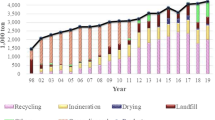Abstract
The drying characteristics of water treatment process (WTP) sludge were investigated with a fluidized bed. The equilibrium moisture ratio of WTP sludge increased with relative humidity and decreased with temperature of drying air. However, equilibrium moisture ratio of WTP sludge was more sensitively dependent on relative humidity than temperature of drying air. When the sludge was dried in a batch fluidized bed, the drying rate of sludge decreased as the moisture ratio of sludge in the bed decreased. The periods of constant drying rates were apparently not observed on the drying rate curves. In addition, the maximum drying rates were increased with bed temperature and superficial air velocity. As the fluidized bed was operated continuously, the degree of drying of WTP sludge increased with bed temperature but was weakly dependent on superficial air velocity. However, the drying efficiency was decreased with bed temperature and relatively insensitive to superficial air velocity and increased with feed rate of sludge.
Similar content being viewed by others
References
Kunii, D. and Levenspiel, O., “Fluidization Engineering,” 2nd ed., Butterworth-Heinmann, Boston (1991).
Lee, D. H. and Kim, S. D., “Drying Characteristics of Starch in a Fluidized Bed,” Proc. 3rd Asian Conf. on Fluidized-Bed & Three-Phase Reactors, Kyungju, Korea, 533 (1992).
Lee, D. H. and Kim, S. D., “Drying Characteristics of PVC Resin in a Inert Medium Fluidized Bed,”HWAHAK KONGHAK,32, 463 (1994).
Nakagawa, N., Ohsawa, K., Takarada, T. and Kato, K., “Continuous Drying of a Fine Particle-Water Slurry in a Powder-Particle Fluidized Bed,”J. of Chem. Eng. Japan,25, 495 (1992).
Ormos, Z. and Szentmarjay, T., “Economic Considerations in Fluidized Bed Drying of Pastes Using Inert Particles,”Drying Tech.,5(4), 577 (1987).
Reay, D. and Baker, C. G. J., “Fluidization,” 2nd ed., Davidson, J. F., Clift, R. and Harrison, D., eds., Academic Press, London (1985).
Shin, Y. S., Hwang, C. S., Kim, T. K., Lee, J. K. and Chun, H. S., Proc. 5th Asian Conf. on Fluidized-Bed & Three-Phase Reactors, Hsitou, Taiwan, 176 (1996a).
Shin, Y. S., Lee, J. K., Lee, H. T., Jin, K. T. and Chun, H. S., “Measurement of Moisture Distributions in Municipal Sewage Sludge using Drying Curves,”J of KSEE,18(9), 1061 (1996b).
Tsang, K. R. and Vesilind, P. A., “Moisture Distribution in Sludges,”Wat. Sci. Tech.,22(12), 135 (1990).
Yoshida, M., Legros, M., Imakoma, H. and Okazaki, M., “Approximate Isothermal Drying Curves of Hygroscopic Porous Materials with Variable Surface Concentration,”J. of Chem. Eng. Japan,30(3), 440 (1997).
Xu, J. Y., Osada, S. and Kato, K., “Limiting Efficiency for Continuous Drying of Microparticle Slurries in a Powder-Particle Spouted Bed,”J. of Chem. Eng. Japan,31(1), 35 (1998).
Author information
Authors and Affiliations
Corresponding author
Rights and permissions
About this article
Cite this article
Shin, YS., Kim, H.C. & Chun, H.S. Drying of water treatment process sludge in a fluidized bed dryer. Korean J. Chem. Eng. 17, 22–26 (2000). https://doi.org/10.1007/BF02789248
Received:
Accepted:
Issue Date:
DOI: https://doi.org/10.1007/BF02789248




